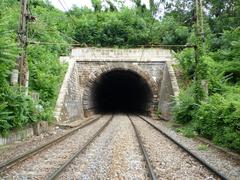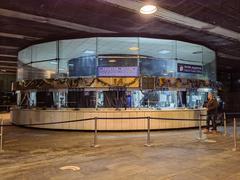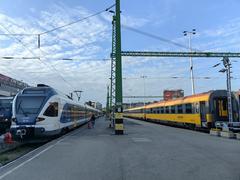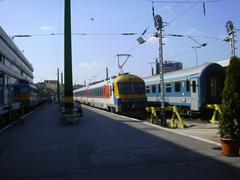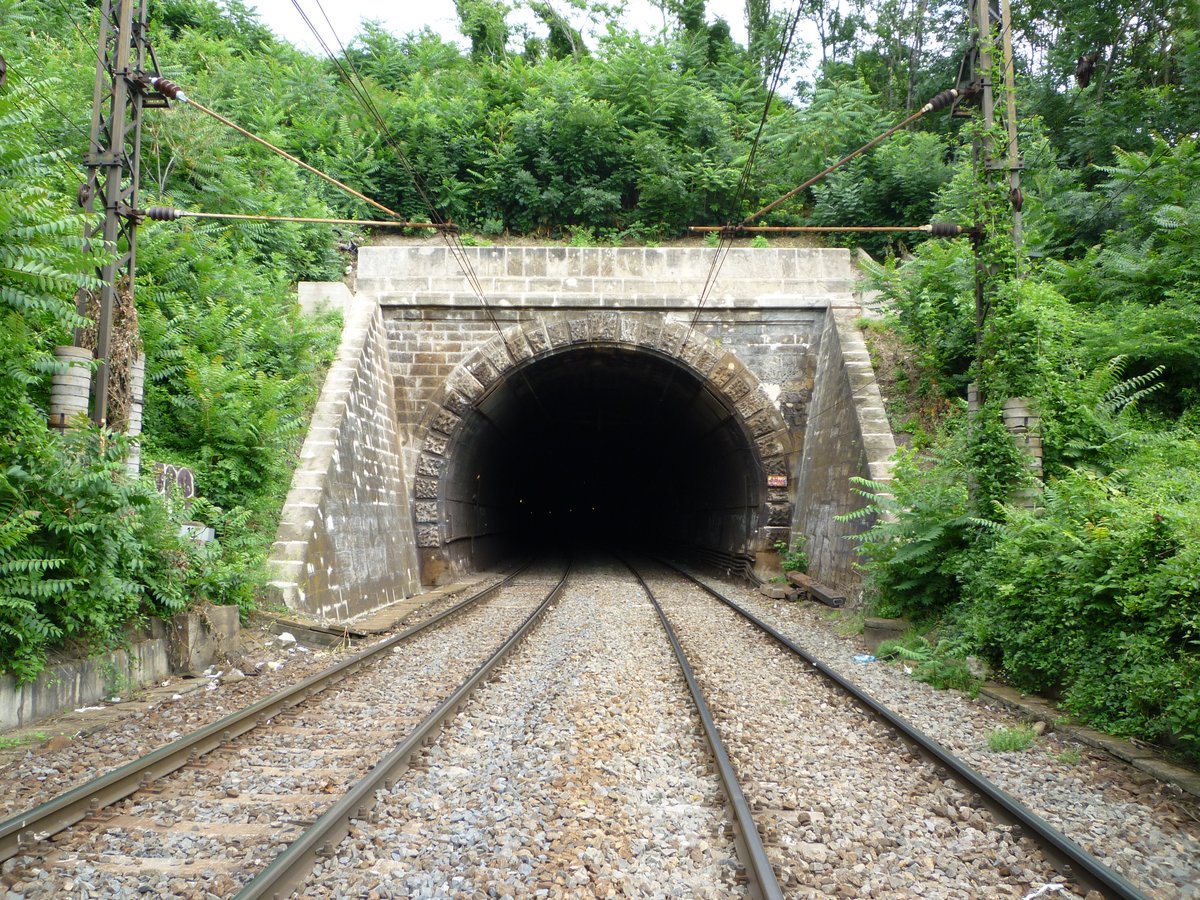
Budapest-Déli Railway Station: Visiting Hours, Tickets, and Comprehensive Travel Guide
Date: 14/06/2025
Introduction
Budapest-Déli Railway Station, known locally as Déli pályaudvar, stands as a pivotal transportation hub and modernist architectural landmark in Budapest’s scenic Buda district. Since its inauguration in 1861, Déli has played an essential role in connecting Budapest with western and southern Hungary, serving as a gateway to popular destinations such as Lake Balaton. With its strategic location near Vérmező park and the historic Castle District, Déli Railway Station is not only a crucial node in Hungary’s rail network but also a window into the urban, cultural, and architectural evolution of Budapest.
This detailed guide provides all the essential information you need to visit Budapest-Déli Railway Station: from its rich historical background and design highlights to up-to-date visiting hours, ticketing options, accessibility features, nearby attractions, and practical travel tips. Whether you are a traveler, history buff, or architecture admirer, the station offers a unique experience at the crossroads of past and present.
For further historical context and architectural insights, see PestBuda and the Kiscell Museum.
Contents
- Early Foundations and Historical Significance
- Architectural Evolution and Modernist Redesign
- Wartime Destruction and Recovery
- Connectivity and Services Today
- Visiting Hours and Ticketing
- Accessibility and Traveler Facilities
- Public Transport Integration and Directions
- Nearby Attractions and Amenities
- Practical Travel Tips
- Frequently Asked Questions (FAQ)
- Key Dates and Milestones
- Conclusion and Travel Planning Resources
- Sources
1. Early Foundations and Historical Significance
Budapest-Déli Railway Station opened in 1861 as the terminus of the Southern Railway (Déli Vasút), connecting Budapest with vital regions of Transdanubia and the Adriatic port of Fiume (now Rijeka, Croatia). The station’s establishment spurred economic growth by enabling Hungary’s agricultural exports, particularly grain, to reach international markets (PestBuda). Its location—chosen after debates between riverside and Buda foothill options—cemented its status as a major western and southern gateway for both goods and people.
2. Architectural Evolution and Modernist Redesign
Originally a utilitarian structure, the station was expanded in 1901 with a new ticket hall and improved platforms to accommodate increasing passenger numbers (PestBuda). Post World War II, after the building suffered extensive damage during the Siege of Budapest, temporary facilities were used for nearly two decades.
A major transformation came in the early 1970s, when architect György Kővári led the modernization of Déli. Completed in 1972, the new station showcased bold geometric forms, extensive glass, and concrete elements—a hallmark of Hungarian late modernism (Kiscell Museum). Interior features like blue-green ceramic tiles and modular seating enhanced both functionality and aesthetics, while the use of Balatonalmádi red limestone anchored the building in the Hungarian landscape.
3. Wartime Destruction and Recovery
Déli pályaudvar was heavily damaged during World War II, especially in the 1944–45 Siege of Budapest. Despite this, provisional services were quickly restored by 1945, and the station continued to serve as a vital passenger hub throughout the postwar years (PestBuda). Later developments included electrification in 1983 and subsequent upgrades to platforms and passenger facilities.
4. Connectivity and Services Today
Déli is one of Budapest’s three main railway stations, alongside Keleti and Nyugati. It serves as the primary departure point for trains to western and southwestern Hungary—most notably to Székesfehérvár, Pécs, and Lake Balaton—as well as select international routes to Croatia and Slovenia (The Trainline). The station integrates seamlessly with Budapest’s urban transport network, including Metro Line 2, trams, and buses, making it a multimodal travel hub (Moovit).
5. Visiting Hours and Ticketing
Operating Hours
- Station Building: Open daily from 4:30 AM to midnight; platform access aligns with train schedules.
- Ticket Offices: Generally open from 5:00 AM to 10:00 PM.
Ticket Purchase Options
- At the Station: Staffed counters and automated machines (accepting cash and cards).
- Online: Via the MÁV website or mobile app.
- Third-Party Platforms: The Trainline and others.
Tip: Purchase tickets in advance during peak periods to avoid queues. For public transport in Budapest, integrated travel passes (24h, 72h, 7-day) are available at the station.
6. Accessibility and Traveler Facilities
Déli Railway Station is designed to accommodate all travelers:
- Wheelchair Access: Ramps, elevators, tactile paving, and accessible toilets.
- Assistance: Staff support available at request; advance notification recommended for special needs.
- Lockers and Luggage Storage: Available for rent inside the station (seat61.com).
- Restrooms: Clean facilities for a small fee (100–200 HUF).
7. Public Transport Integration and Directions
- Metro: Déli is the western terminus of Metro Line 2 (M2, red line), with direct service to the city center and connections to all major metro lines.
- Trams: Lines 17, 56, 61 (to Buda neighborhoods and Széll Kálmán tér).
- Buses: Multiple city and regional lines, with convenient night bus options.
- Taxis/Rideshare: Official taxi ranks outside the station; use trusted apps like Bolt (Uber not available in Hungary).
- Suburban Rail (HÉV): Accessible via Batthyány tér, two stops away on Metro Line 2, for day trips to places like Szentendre (Budapest by Locals).
For step-by-step route planning, consult Budapest public transport portal.
8. Nearby Attractions and Amenities
- Buda Castle District: UNESCO World Heritage site, museums, and panoramic views.
- Matthias Church & Fisherman’s Bastion: Iconic landmarks, easily reached by tram or on foot.
- Vérmező Park: Ideal for relaxation before or after your journey.
- Cafés and Shops: Eateries, bakeries, and shops within the station and surrounding area.
- Vagon Étterem: A unique dining experience in a converted railway car across the road (seat61.com).
9. Practical Travel Tips
- Currency: Use Hungarian forints for purchases; ATMs are available in the station, but avoid Euronet-branded machines for better rates (Lonely Planet).
- Safety: The station is generally safe, but stay vigilant for petty theft.
- Lost & Found: Inquire at the information desk or with MÁV staff for lost items (rail.cc).
- Wi-Fi: Limited free Wi-Fi; available in some cafés and waiting areas.
10. Frequently Asked Questions (FAQ)
Q: What are Budapest-Déli’s opening hours?
A: Open daily from 4:30 AM to midnight; ticket offices 5:00 AM–10:00 PM.
Q: How can I buy tickets?
A: At counters, machines, or online via MÁV or The Trainline.
Q: Is the station accessible?
A: Yes—ramps, elevators, and staff assistance are available.
Q: Are there luggage storage options?
A: Yes, lockers are provided for a fee.
Q: How do I reach the city center from Déli?
A: Use Metro Line 2 (M2) for direct access to Deák Ferenc tér.
Q: What historical sites can I visit nearby?
A: Buda Castle, Matthias Church, Fisherman’s Bastion, Vérmező Park.
11. Key Dates and Milestones
- 1861: Station opens as Southern Railway terminus.
- 1901: Major expansion with new ticket hall.
- 1944–45: Severe WWII damage; provisional reopening in 1945.
- 1972: Modernist station completed.
- 1983: Electrification of lines.
- 2001: Platform upgrades.
- 2016: Station retained with future redevelopment plans.
- 2022: Approval for a railway tunnel connecting Déli and Nyugati (RailwayPro).
12. Conclusion and Travel Planning Resources
Budapest-Déli Railway Station is much more than a transit gateway—it is a vibrant, living testament to Hungary’s railway heritage and urban transformation. Its modernist design, accessibility, and integration with the city’s public transport make it an essential stop for both travelers and urban explorers. With ongoing developments, including the planned tunnel to Nyugati, Déli’s role in Budapest’s future is assured.
For the smoothest experience, plan ahead by checking current schedules on the official MÁV website, use the MÁV app for ticketing and updates, and explore the surrounding Buda attractions. Download the Audiala app for further travel tips and follow local tourism sites for special events and guided tours.
13. Sources
- The connection between Nyugati and Déli railway stations was also planned in the 19th century, now it is made underground, PestBuda
- Budapesthez méltó épület: A fővárosi pályaudvarok története, PestBuda
- Déli Railway Station Budapest: Visiting Hours, Tickets & Architectural Highlights, Kiscell Museum
- Erőd is volt, majd megsemmisült – a Déli pályaudvar története, WeLoveBudapest
- Budapest Rail Development Strategy Approved, RailwayPro
- Budapest-Déli Railway Station: Visiting Hours, Tickets, and Connectivity Guide, Moovit & The Trainline
- Budapest-Déli Railway Station Complete Guide, Budapest Public Transport Portal & Seat61
- Budapest by Locals: Visit Budapest in June
- Wikipedia: Budapest Déli station
- JustBudapest: Railway Stations - South, West, East
- Budappest.com: How to Get to Budapest – Arriving by Train
- Rail.cc: Budapest Déli pu.
- Lonely Planet: Things to know before traveling to Budapest
- Travel Notes and Beyond: Budapest Travel Tips
- Budapest Travel Guide: Castle District
- BKK Budapest Public Transport Portal
- MÁV Hungarian State Railways official website
